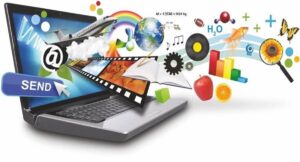SHARE WITH FRIENDS:
Topic: Multimedia systems and technologies. Basic concepts.
Plan:
-
Multimedia systems and technologies. Basic concepts.
-
History of development of multimedia.
-
The main advantage of multimedia technologies
-
Multimediaareas of application
Multimedia systems and technologies. Basic concepts.
The term "multimedia" is formed from the words "multi" - many and "media" - environment, carrier, means of communication. These words can be translated into Uzbek as "much happy".
Multimedia is a set of various computer technologies that use information in various forms and forms, such as graphics, text, video, photography, moving images (animation), sound effects.
As a rule, multimedia means the combined use of visual and audio effects controlled by interactive software.
Here are some examples of the concept of "multimedia":
-
Multimedia (multimedia) is a modern computer information technology that allows to use text, sound, video image, graphic image and animation (multiplication) together in a computer system.
-
Multimedia is a set of technologies that enable input, processing, storage, exchange, and representation of information such as text, graphics, animation, digital still images, video, sound, and speech on a computer.
-
Multimedia is an interactive system that provides images and motion video, animated computer graphics, and text, speech, and high-quality sound.
A multimedia computer is a computer with hardware and software that implements multimedia technologies.
History of development of multimedia.
Multimedia technologies are considered one of the most relevant and popular areas of informatics. The main goal of this direction is to create products that "have a collection of images, text and text sound, video animation and other visual effects (Simulation), and have an interactive and other visual control mechanism." This concept was defined in 1988 by the large European Commission dealing with the problems of application and use of new technologies.
At the end of the 80s, the increase in interest in the use of multimedia technologies in humanitarian fields is directly related to the name of the famous American computer businessman Bill Gates. He put forward the idea of creating and successfully using multimedia products based on various "atmospheric" systems: image, sound, animation and hypertext ("National Art Gallery, London").
It was this product that embodied the following 3 main principles of multimedia:
-
Representation of data using a combination of different human-perceptible data environments.
-
The presence of different lines of information description in the product (in particular, the person defines the information description line through the control mechanism present in the product).
-
Artistic interface design and navigation tools.
The main advantage of multimedia technologies
The main advantage and distinctive feature of multimedia technologies are the following possibilities of multimedia actively used in data visualization:
-
The ability to store large amounts of various types of data on one medium (up to 20 author's names, 2000 and more high-quality images, 30-45 minutes of video recording, 7 hours of sound);
-
The presence of the possibility of enlarging (detailing) the image or its necessary part on the screen. In some cases, it is possible to magnify up to 20 times while maintaining image quality ("magnifying glass" mode). This is especially important when displaying works of art and rare historical documents.;
-
Image comparison and image processing using various software tools for scientific research and dating purposes;
-
Featured image: the ability to highlight a "keyword (or field)" in text or visual material and use this highlighted element to provide a quick reference or other explanatory (also visual) information (hypertext or hypermedia technology ) get;
-
The ability to display a static image or an optional dynamic visual sequence together with continuous music or audio;
-
The ability to use video fragments from movies or video recordings and the functions of khakoza, i.e. "stop - frame", scrolling through the video recording frame by frame;
-
Ability to include image processing methods, animations, etc. in the database;
-
The ability to connect to the global Internet;
-
Ability to work with various programs (text, graphic and sound editors, cartographic information);
-
A private "gallery" (selection) from the information contained in the product ("carman" or "notes" mode);
-
the ability to "remember the path" or create "layers" on the necessary screen "page";
-
Automatic viewing of all information contained in the product ("slide show") or inclusion of an animated or voice "guide" in the content of a multimedia product; the possibility of including game components in the product;
-
The availability of "free" navigation through information and quick return to the main menu (main content), as well as the ability to quickly switch to the optional point of the product.
Multimediaareas of application
-
Teaching using computer technologies (according to the results of special studies, a quarter of what is heard is remembered in memory, a third of what is seen is remembered, and 50% of what is seen and heard at the same time is remembered. If the user receives multimedia applications 75 percent will remember if they are actively involved in the learning process).
-
Information and advertising service.
-
In entertainment, gaming and virtual reality systems.
Control questions:
-
Multimedia systems and technologies. Basic concepts.
-
History of development of multimedia.
-
The main advantage of multimedia technologies
-
Fields of multimedia application
